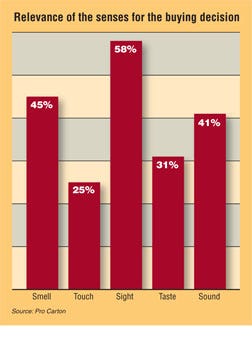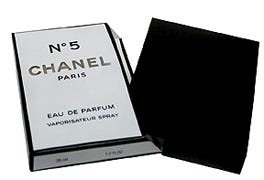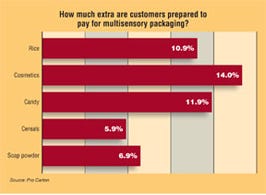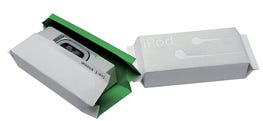Multisensory packaging design increases brand loyalty, shelf impact
January 30, 2014

Sensuality is enticing, which is why producers of brand-name goods are increasingly banking on differentiation through point-of-sale (POS) packaging that appeals to all human senses.
Multisensoric is more than just a new buzzword in packaging design.
When affection develops between two people, a multisensory situation occurs: The five senses of touch, taste, smell, sight and sound come into play. After the proverbial "first glance" come tactile, acoustical, olfactory and gustatory stimuli that arouse the "ultimate emotions." And since the latest research findings tell us that the brain ignores brands, producers of brand-name goods and packaging experts are well advised to appeal to consumers at the POS in a multisensoric manner by using their products and packaging to stimulate and arouse emotions.
Those who make their brand multisensoric send a bundle of signals that the brain directly converts into buying impulses. The results are staggering. When consumers can recall multiple sensory impressions that a product has conveyed, brand or product loyalty is around 60 percent. But if only one sensory impression is conveyed and recalled, this value is halved. And so, multisensoric strategies to attract and hold customers use touch, taste, smell, sight and sound to make brands appealing and to influence buying decisions both cleverly and selectively.

That Chanel sound.This package for the perfume classic Chanel N° 5 not only looks valuable, it sounds valuable as well. When the package is opened, a magnetic mechanism produces a pleasing, high-quality sound. Elisabeth Warkus took first prize in the Multisensory Packaging competition held at the 6th Pro Carton Congress with this bright idea.
Because direct contact between the consumer and the goods takes place at the POS, this is the opportunity, and indeed the task of packaging above all, to turn sensory stimulation into a buying impulse—a volatile yet so far virtually unknown topic.
The 6th Pro Carton Congress, held last year in Germany by Pro Carton (www.procarton.com), the European Association of Carton and Cartonboard manufacturers, dealt extensively with multisensorics. At the event, renowned experts spoke about mechanisms and possibilities, and they emphasized the significance of a multisensory consumer approach for branding, marketing and packaging. They also made clear what an enormous, untapped potential there is for a new generation of branding and packaging design, and suggested ways to take advantage of this.
One of these speakers was Martin Lindstrom, who is hailed as a "World's Brand Futurist." Lindstrom opposes the customary overestimation of sight and makes it clear that smell, with a 45-percent impact, sound (41 percent), taste (31 percent) and touch (25 percent) are just as relevant for the buying decision as sight (58 percent). Lindstrom forecasts that two out of every 10 of the world's leading producers of brand-name goods will soon analyze and redefine their so-called brand signature. This will result, he says, in multisensory strategies to secure sustained loyalty for their brands—and thus to secure their existence as well. This, of course, also means optimizing the design of their product packaging as a component of branding.

Specialists Oliver Figge and Jens Ole Kracht from MetaDesign (www.metadesign.de) have come to similar conclusions and recommend multisensory brand management, which they claim can considerably increase brand attraction. Say Figge and Kracht, "The dominance of classic advertising is over. Spreading the advertising budget over many media forms has had its day. The solution is not more communication with brighter and brighter pictures, which means ever-increasing advertising costs. The challenge is not to expand communication but to make more effective use of existing resources. Direct and targeted communication is where the future lies."
And what can be more direct and effective than a product's packaging? Probably no other advertising medium can. After all, it's the packaging that is face-to-face with the consumer in the moment the buying decision is made.
Dr. Hans-Georg Häusel of Gruppe Nymphenburg (www.nymphenburg.de) is among the world's leading experts in applying findings from brain research to questions of consumer behavior, marketing and brand management. The findings he presented at the Pro Carton Congress tally with the convictions of Lindstrom, Figge and Kracht. "A brand, product or service transmits many signals and stimuli, so-called cues, that consumers are often not conscious of but which are nevertheless highly effective," says Häusel. "Those wanting to animate and fascinate their customers and gain an unassailable lead over the competition must pay attention to the total selling process, starting with the brand and continuing with the smallest product detail and going right through to presentation of the product on store shelves."
With the new study "The 2006 Shopper at POS," Dr. Stefan Müller of the market research Institute Information Resources, Inc. (IRI [us.infores.com]) confirms that multisensory components in packaging design stimulate the buying impulse and influence the decision between products. One example he cites of a successful product is Celebrations(R) Chocolates from Masterfoods. This product is presented in an octagonal package with a striking red-and-gold color scheme, a window to view the product, exciting rustling sounds and a foldout tray. These features, he notes, provide a combination of signals and stimuli that strongly appeal to consumers and thus have generated a very high market share for Celebrations. This example impressively proves the results of the study: More than 60 percent of consumers want multisensory packaging and are prepared to pay for it.

Fragrance for iPod. With its flaky surface and seal, this iPod carton has the appearance of a food-preservation package. When it57;s opened, a breath of fragrant spring air surprises the consumer. This idea from Siren Elise Wilhelmsen won her third place in the Pro Carton Congress Multisensory Packaging competition last year.
Already today, there are many highly innovative possibilities to meet the demand for multisensory appeal at POS via the carton material, the sales packaging and the POS display. There is already a lot of product packaging that demonstrates the potential of appealing to the five senses by using modern packaging technology. The manifold combinations of construction and graphic enhancement provide an almost unlimited scope for multisensory packaging design. These include carton quality (surface structure and smoothness, rigidity to withstand crushing), printing (printing process, colors, scented coatings), enhancement (foil laminating, foil stamping, relief embossing, coding), die-cutting, gluing, window patching or sound effects.
All experts at the Pro Carton Congress were unanimous in their message: Multisensoric is one of the most effective, future-oriented strategies for successful branding and packaging, especially for POS packaging made of paperboard.
This article was written by Jürgen Bihler and was reprinted with permission from issue 21 of expressis verbis, a publication of MAN Roland Druckmaschinen AG.
More information is available:
Gruppe Nymphenburg Consult AG, +49 (0)89 549021-0. www.nymphenburg.de.
Information Resources, Inc. (IRI), 312/726-1221. us.infores.com.
MetaDesign AG, +49 30 59 00 54-0. www.metadesign.de.
Pro Carton, +32 (0) 2 640 4955. www.procarton.com.
You May Also Like


